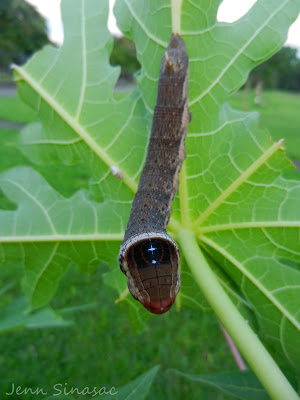Next to birds, insects are a very fascinating group of animals to me. Especially lepidopterans - butterflies and moths. I don't know what it is I like about them so much - their beauty, diversity, adaptations, an interest to follow their classification, and I really enjoy the challenges of identification. Furthermore, they have changes in their life cycle that make it all the more fun to identify. They undergo complete metamorphosis and their larvae, better known to us as caterpillars, are physically diverse with a wide variety of adaptations and defenses themselves. So needless to say, wherever I am, coming across caterpillars is always entertaining for me.
We recently went for a walk in Gamboa on a nice breezy afternoon after a rain. As I now always try to have my camera with me, we stopped to photograph a sedge, of all things! There is a species of sedge here, superficially resembling a grass, that appears to have been spray-painted the tops, which spread out in 3-6 blades, with the colour white. Plants are not my strong point, so if anyone can help me with its identification, it would be much appreciated! They are particularly pretty, so worth a stop to snap a few photos.
After I got some photos, we noticed something hanging off a small papaya tree planted in the boulevard. Upon closer investigation, it was a caterpillar, hanging off one of the papaya leaves. At the base of the tree, there were two more. These caterpillars were large, up to 10 cm long, and had a "horn" protruding from the back of its abdomen, a characteristic of "hornworms" or Sphinx moth caterpillars, in the family Sphingidae. This is the larva of Alope Sphinx, Erinnyis alope. This widespread species ranges from extreme southern United States through the tropical regions of Central and South America and the Caribbean, and even has a subspecies endemic to the Galapagos Islands! The caterpillars feed on papaya, which was a nice confirmation of its species. When in its dark phase, it is similar in appearance to Errynis ello, which rather feeds on pointsettia.
 |
| Alope Sphinx caterpillar, Errinyis alope |
 |
| Alope Sphinx caterpillar, Errinyis alope |
Furthermore, to get a closer look at these larvae, we moved the leaf around and the caterpillar, alarmed, widened its thorax, which was a darker color than the rest of its body, and had a unique, white "starburst" marking, perhaps even resembling an eye. It protruded its thorax, and reminded me of a caterpillar I saw posted on Facebook a few months ago of an Elephant Hawk-moth Caterpillar (Deilephila elpenor) from Europe & Asia that, when startled, can change its thorax to resemble the head of a pit-viper. Its head is actually tucked under its body when it is in this defense position.
 |
| Alope Sphinx caterpillar, Errinyis alope |
While watching the caterpillars on the small papaya tree, we couldn't help but worry about their conspicuous appearance (being so big they were not difficult to see), and that they would be particularly appetizing to a passing thrush or antshrike. Caterpillars evade predation in a number of ways, and depending on the species, have a variey of effective defenses, from resembling snakes and bird poop, to either exposed or concealed stinging spines containing potent toxins, toxic urticating hairs, aposematic (warning) coloration to announce to any potential predator that it would not be a tasty snack. Check out this article for more examples of caterpillar defenses (and good photos). By rearing up and showing off that large 'eye', perhaps this is how Errinyis alope avoids being eaten.
A Caterpillar Warning:
When growing up, I remember playing with caterpillars in my backyard. Down here in Tropical America, I think twice about every caterpillar I see, and as a general rule, do not touch! On more than one occasion, I have suffered stings from tropical caterpillars (however, stinging caterpillars are not restricted to the tropics, and can be found in temperate regions as well), and it is not a pleasant experience. Caterpillars that sting and have urticating hairs can be quite toxic, and reported cases of human deaths due to caterpillar stings are not unheard of. Just a word of advice and worth keeping in mind if traveling to the tropics, its a wild world down here, and creatures like caterpillars may not always be as friendly as they seem. That being said, they are still cool to come across!
~ Jenn

No comments:
Post a Comment